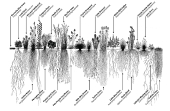





















R J West wrote:I made a Watering Wand that puts out the water a least twice as fast of conventional ones, saves time in Hand Watering if anyone is interested I can post instructions on how to make one, cost is less than $10.
John Elliott wrote: If you are raising a variety of Chilean mesquite and you want it to develop a 200' taproot, better plant it directly in the ground and let the taproot develop undisturbed.
Works at a residential alternative high school in the Himalayas SECMOL.org . "Back home" is Cape Cod, E Coast USA.




John Elliott wrote:I think it would depend on how you want the taproot of the seedling to develop. I have seen oak seedlings that are around 4" tall that already have a taproot longer than the 8.25" of your SC10 cone-tainer. Needless to say, once the taproot hits bottom, you would want to get it out to its final location or the taproot will grow in some freaky manner not in keeping with its own nature. If you are raising a variety of Chilean mesquite and you want it to develop a 200' taproot, better plant it directly in the ground and let the taproot develop undisturbed.
However, if you intention is to grow a bonsai tree or something like a bald cypress that has a spreading tangle of shallow roots, 8.25" is plenty deep.
Now that I have mentioned both the deepest and shallowest rooting trees that I can think of, I would suggest a rule-of-thumb that you plant them out when you have as much above the soil level as below, i.e., when the seedlings get about 8" tall. [/quo
John,
Unfortunately in the Sonoran Desert there is from 2' to 6' thick of Coleache, (concrete like substance) from 1' to 10' under the top soil. There is no tap root that can penetrate this. Your rule of thumb theory makes a lot of sense, when the Tree Seedling is 8.25" tall the tap root will be as long or longer. There are Tree Pots that are over 24" deep. I know another Grower that has Trees in 4" PVC tubes that are over 4' tall. This is a method used in Reforestation, a 6" auger is drilled 4' deep and the screen at the bottom of the tube is taken off, the tube is placed in the 4' hole then pulled up over the tree. The roots are never touched by human hands, then the tree is watered and a jell is placed around the stem and releases water over a period of time. There is no irrigation when planting for Reforestation, and sometimes it doesn't rain for months. I don't doubt Mesquite tap roots can get very long if given a chance. By taking a Tree Seedling out of the cone-tainer probably would be the best way to know when to Pot Up!
Thanks again for your input, most members just read and don't contribute!




Rebecca Norman wrote:
R J West wrote:I made a Watering Wand that puts out the water a least twice as fast of conventional ones, saves time in Hand Watering if anyone is interested I can post instructions on how to make one, cost is less than $10.
Yes I'm interested in your watering wand. Does it hook to a hose and require water pressure, or is it handheld?
John Elliott wrote: If you are raising a variety of Chilean mesquite and you want it to develop a 200' taproot, better plant it directly in the ground and let the taproot develop undisturbed.
Whoah, 200' taproot?! Are there any trees like that, that can grow in a temperate climate, ie with a cold winter? Wow! Our land has some 70' of bone dry soil before the groundwater at about 75 or 80 feet deep. Would one have to somehow tempt the taproot down with moisture all the way down, or how would that be done?








Rebecca Norman wrote:
Whoah, 200' taproot?! Are there any trees like that, that can grow in a temperate climate, ie with a cold winter? Wow! Our land has some 70' of bone dry soil before the groundwater at about 75 or 80 feet deep. Would one have to somehow tempt the taproot down with moisture all the way down, or how would that be done?









|
Shiny ad:
Freaky Cheap Heat - 2 hour movie - HD streaming
https://permies.com/wiki/238453/Freaky-Cheap-Heat-hour-movie
|


